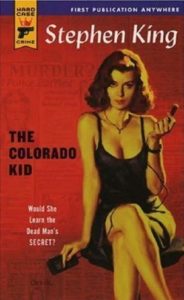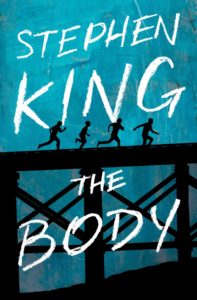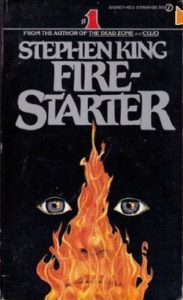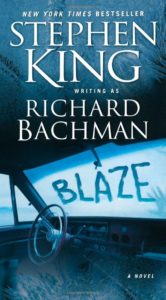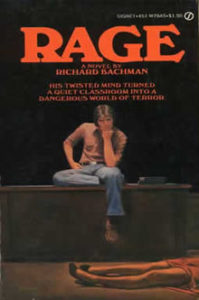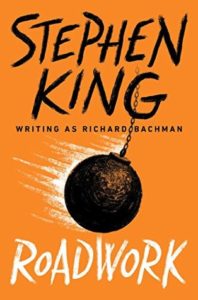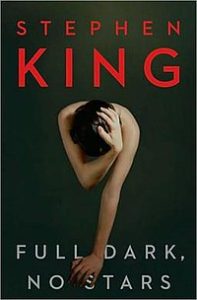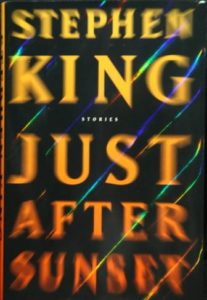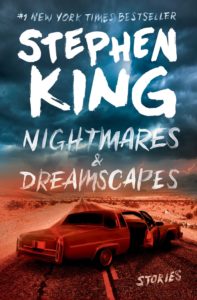When news of Stephen King’s latest novel, The Outsider, first broke, the horror community found themselves divided into two camps: those willing to welcome this new title with the same enthusiasm as his previous publications, and those disappointed that King had once again decided to release something under the crime umbrella. Maybe this latter group figured he’d gotten the genre all out of his system now that he’d concluded his Bill Hodges trilogy about an ex-cop tracking down a serial killer (Mr. Mercedes, Finders Keepers, and End of Watch) and he would finally return to his horror roots. Which is odd, because while, yes, The Outsider is a crime novel, it also clearly falls under horror. Nearly every book can be classified under multiple genres. It’s what makes them interesting. And horror and crime? I can’t think of a more exciting tag team.
Stephen King knows crime. He grew up mainlining pulp legends like Richard Stark and John D. MacDonald. He was a goddamn noir geek, if you want to know the truth. When MacDonald agreed to write the introduction for King’s debut collection, Night Shift, he nearly pissed himself. Read any interview or essay where King discusses his early inspirations, and you’re bound to find numerous hardboiled writers’ names machine-gunned out as a response. His books are littered with references to his writing heroes. Without crime fiction, there is no Stephen King. It has inspired his rage against the system, his attitude toward certain political states of mind. One has to wonder what King’s approach to writing would be like if he hadn’t grown up devouring pulp fiction. At the very least, I suspect his output wouldn’t have exhibited such an exuberant frequency. The life of a pulp writer depended on typing until their fingers bled, sometimes finishing entire novels in less than a month. They wrote stories about terrible people doing terrible things and readers still to this day can’t get enough of it. In King’s fiction, nobody’s perfect. Everybody has their baggage. Protagonists often commit crimes, take the law into their own hands, do whatever it takes to get shit done. It’s a simple, complicated truth, but there’s no denying the people who shape us into what we become.
While it’s true that the majority of King’s work features supernatural elements, there’s no denying the fact that many if not all of them can also be classified as thrillers. Just because you throw in a ghost or child-eating subterranean monster, it doesn’t mean you still don’t have a thriller on your hands, too. Fiction is not restricted to only one genre, and that’s perhaps why Stephen King has earned such a successful career. He has been branching out since the very beginning of his career, incorporating elements from various genres and making them his own. The two biggest genres being horror, yes, but also crime fiction. His books are fueled by the ethos of classic thrillers.
People sometimes forget that Stephen King has been writing crime fiction long before the recently released Bill Hodges trilogy (which includes Mr. Mercedes, Finders Keeper, and End of Watch). This is the genre he grew up on, so it makes sense that his own work would pay it forward, both with his own work, and his frequent mentorship of young writers. One look at his Twitter account will clearly show that he’s still endorsing up-and-comers in the industry. King has written and read pretty much every kind of crime novel you can imagine, and this list attests to his diversity of approach.
The Hard-Boiled Stephen King
In celebration of Stephen King, the crime writer, we thought we’d go over his vast bibliography and highlight some of his ventures into crime fiction. So, let’s get the obvious titles out of the way first and tackle the undeniably hard-boiled, like his Hard Case Crime original paperbacks, The Colorado Kid and Joyland. King’s love for a good, gritty murder mystery has never been more present than in The Colorado Kid. Arguably one of King’s most underrated novels, it involves a rookie newspaperwoman investigating a 25-year-old cold case. Reactions were strong against this one when it first came out, but perhaps a stronger appreciation for it has grown since the TV adaptation (Haven). No clear resolution is offered in The Colorado Kid, which upset a lot of casual horror fans not too versed in hard-boiled mysteries, but honestly? It’s kind of perfect and begs to be revisited by diehard “constant readers” who originally shrugged it off. His second HCC paperback, Joyland, features nearly the same plot, except this time he replaces “rookie newspaperwoman” with “rookie carnie-boy.” These are the easiest of King’s novels to classify under the crime/mystery genre thanks to the publisher’s legacy of releasing gloriously pulpy crime fiction, plus those beautiful front covers by Glen Orbik and Robert McGinnis really help emphasize what the reader is getting themselves into. There’s not a crime writer alive today who doesn’t fantasize about one day publishing a paperback with Hard Case Crime (Yo, Ardai, if you’re reading this: hit me up).
Prison Noir
Other titles that should immediately spring to mind thanks to their rather famous film adaptations: Rita Hayworth and Shawshank Redemption (filmed as The Shawshank Redemption) and The Green Mile. Both stories set within the confines of a prison, centered around convicts and the guards who watch over them. Each tale digs deep into life “on the inside” and investigate at length what makes so-called “bad men” do bad things. They also achieve what every great neo-noir ought to aspire of accomplishing: making the reader root for the criminals. Rita Hayworth and Shawshank Redemption is narrated by a man (played by Morgan Freeman in the film adaptation) who not only murdered his wife, but also his neighbor and the neighbor’s child, and by the end of the novella, we kind of forget all about his past crimes because we’ve fallen in love with the dude. The Green Mile shares similar themes of inmates and guards forming bonds together. King originally serialized it over a six-month period under the following titles: The Two Dead Girls, The Mouse on the Mile, Coffey’s Hands, The Bad Death of Eduard Delacroix, Night Journey, and Coffey on the Mile.
Rita Hayworth and Shawshank Redemption was originally published in a collective quartet of novellas titled Different Seasons. The other three titles found in this collection include Apt Pupil, The Body (filmed as Stand By Me), and The Breathing Method. None of the novellas had previously been published or even submitted elsewhere. In the book’s introduction, King admits to feeling like he’d been “written off” as someone who only wrote horror fiction. This collection ended up being his “Fuck you, I’ll write whatever I goddamn please” salute. Of the four novellas found in Different Seasons, all but The Breathing Method could easily fall under crime fiction. The Body details a journey made by four children as they search for a dead body. Along the way, they commit numerous petty crimes around town. And in Apt Pupil, a teenager blackmails an old man he discovers to be a Nazi-in-hiding. I know it’s hard to remember in the year 2018, but Nazis were actually once considered criminals. Crazy, huh?
Conspiracy Thrillers
Hey, speaking of presidents: one of King’s earliest novels, The Dead Zone, has crime fiction all over it. As of the writing of this article, assassinating political figures is still very much against the law, which happens to be the central plot of King’s book. Johnny Smith, a man who was once very clumsy as a child (specifically, on black ice, which is how he gains his clairvoyant abilities), makes it his life’s mission to stop a murderous sociopath who he believes will one day be elected President of the United States. 11/22/63 is another novel of King’s dealing with presidential assassination, only this time our protagonist is trying to prevent one from happening. Conspiracy thrillers scream loud and proud throughout King’s bibliography. In “The Ten 0’Clock People” (published in Nightmares & Dreamscapes) a group of smokers discover a plot equaling They Live levels of treachery. His 1980 novel, Firestarter, serves as an example of the conspiracy thriller genre at its finest. After two subjects from a top-secret government experiment have a kid together, they find themselves being chased through hell and back by the same shadowy agency. What’s not to love?
Pure Crime Fiction
Go back even earlier than The Dead Zone and you’ll still find King writing crime fiction. Rage, penned while still in college and later published under his Richard Bachman pseudonym, uncovers a school shooting in extremely graphic detail. It was later pulled from publication by the author due to bizarre connections between the book and real school shooters. Many of the titles originally published under Richard Bachman’s name fit into the crime fiction genre, if you think about it. Roadwork is pure crime. Its protagonist is this man whose marriage has fallen apart after the death of their son. Driven pretty much insane by the downward spiral of his life, he purchases a .44 Magnum after learning about a new highway extension project that’ll result in the demolition of his home and workplace. Then, well, you can probably guess what happens next. Dude goes on a fun-for-the-whole-family rampage against the government. Blaze loosely revisions the kidnapping of the Lindbergh baby, while also mixing in themes from Of Mice and Men. The Regulators begins with a mysterious van shotgunning a paperboy in the middle of a suburban street, spiraling the neighborhood into a unintentionally hilarious reimagining of “The Monsters Are Due on Maple Street” from The Twilight Zone. Released alongside The Regulators in an attempt to create mirroring universes we have Desperation (under King’s real name), a novel about a Nevada cop murdering tourists (okay, there’s a little bit more to it than that). Misery was meant to serve as Richard Bachman’s breakout success, but King instead wound up releasing it under his own name after a pesky bookstore clerk discovered Bachman’s true identity and snitched to the press. In Misery, an obsessed fan discovers her hero dying in his car after running it off the road. Instead of seeking help, she keeps him immobilized in her house and forces him to write the perfect novel. We later discover this woman has had a rather curious history as a nurse terminated for literally murdering babies while serving as the head of the maternity wing.
The Dark Half was written after the outing of King’s Bachman pseudonym, and it’s very clearly a tribute to the pen name. The protagonist is a mostly unknown literary author who writes gritty crime fiction under the pseudonym “George Stark”, an obvious nod toward Donald Westlake’s Richard Stark. This fictional George Stark even has an ongoing series very similar to Richard Stark’s Parker. Parker is, of course, a character every reader of this website is undoubtedly already at least somewhat familiar with, so I’m not even going to bother elaborating any further.
Domestic Noir
Returning to the area of novella collections, let’s take a look at King’s most recent one: Full Dark, No Stars. Much like Different Seasons, three out of four contributions from this book radiate crime fiction. We open with one of the best pieces King has ever written: 1922. A man is super grumpy about his wife’s desire to move away from the farm life, so he schemes up a plot to murder her. His co-conspirator? Their little boy, of course. In Big Driver, a mystery writer takes the wrong shortcut on the way home from a book signing and finds herself right in the middle of a rape-revenge fiasco. And A Good Marriage asks the classic question: How would you react upon discovering your spouse is a famous serial killer?
Serial Killers
King has certainly written his share of serial killer stories, too. Obviously there’s The Outsider and the Bill Hodges trilogy, which I already discussed up top. But also, let us not forget that King and Peter Straub once teamed up to channel Albert Fish in Black House (a sequel to their previous novel together, The Talisman). In “The Cat From Hell” (published in Just After Sunset), a hitman is hired to whack a cat known for a long string of murders. However, the most obvious serial killer novel might not be one that immediately springs to mind: IT. Think about It (I’m sorry). For decades, this fucking thing pecks off the citizens of Derry, Maine. Nobody can stop It, at least not until a group of losers band together and conduct a thorough investigation. The only real shame here is the reader is never revealed Bob Gray’s middle name, because It is the definition of a serial killer. I’m also not complaining about the abundance of cool petty crimes committed throughout the novel. Honestly, I’m a sucker for any story about children breaking the law. Nothing in this world makes me happier.
Everything Else
This essay is already getting rather long, and we still haven’t covered all of the crime fiction found in his bibliography. There’s “The Death of Jack Hamilton” (published in Everything’s Eventual), which is a true-crime account of John Dillinger’s first gang. “Dolan’s Cadillac” (published in Nightmares & Dreamscapes) takes the revenge genre to its ultimate limits by burying a mobster alive in his vehicle. King’s Dark Tower series weaves in and out of pretty much every genre imaginable, and crime fiction is no exception. One notable instance from the series would be the entirety of The Drawing of the Three (Book II), which heavily features the mafia and drug smuggling. Hell, his story “Umney’s Last Case” (Nightmares & Dreamscapes) features a crime writer overdosing on pills and finding himself in the world of the fictional private detective he created in his novels.
At one point early on in his career, King attempted to write a Patty Hearst novel titled The House on Value Street, but abandoned the idea to work on The Stand.
From Danse Macabre, his non-fiction book about the horror genre:
“It was going to be a roman a clef about the kidnapping of Patty Hearst, her brainwashing, her participation in the bank robbery, the shootout at the SLA hideout in Los Angeles, the fugitive run across the country, the whole ball of wax.”
To this day I am devastated we do not live in a world with a Stephen King novel about Patty Hearst. Absolutely bummed, I tell ya.



